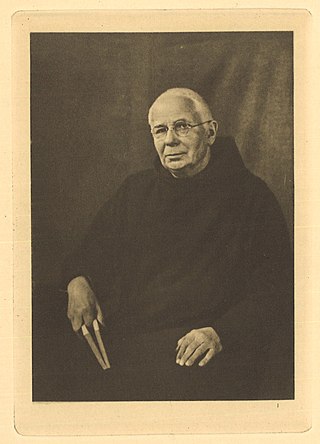
Saint Giles, also known as Giles the Hermit, was a hermit or monk active in the lower Rhône most likely in the 7th century. Revered as a saint, his cult became widely diffused but his hagiography is mostly legendary. A town that bears his name grew up around the monastery he purportedly founded, which became a pilgrimage centre and a stop on the Way of Saint James. He is traditionally one of the Fourteen Holy Helpers.

Hubert of Liège was a Christian saint who became the first bishop of Liège in 708 A.D. He is the patron saint of hunters, mathematicians, opticians and metalworkers. Known as the "Apostle of the Ardennes", he was called upon, until the early 20th century, to cure rabies through the use of the traditional Saint Hubert's Key.
Renier of St Laurent was a twelfth-century Benedictine monk of St Laurent Abbey, Liège. He is known as a writer of theological and exegetical works, controversial and historical works, and numerous biographical and hagiographical works. Works by him are in Patrologia Latina and Monumenta Germaniae Historica.
Ignatius IV (Youssef) Sarrouf was Patriarch of the Melkite Greek Catholic Church in 1812. He is remembered for both his patriarchate, and for having been, as metropolitan of Beirut, a leading figure in the early history of the Melkite Church.

The Princely Abbey of Stavelot-Malmedy, also Principality of Stavelot-Malmedy, sometimes known with its German name Stablo, was an ecclesiastical principality of the Holy Roman Empire. Princely power was exercised by the Benedictine abbot of the imperial double monastery of Stavelot and Malmedy, founded in 651. Along with the Duchy of Bouillon and the Prince-Bishopric of Liège, it was one of only three principalities of the Southern Netherlands that were never part of the Spanish Netherlands, later the Austrian Netherlands, which after 1500 were assigned to the Burgundian Circle while the principalities were assigned to the Lower Rhenish Imperial Circle.
Gerard of Florennes, bishop of Cambrai as Gerard I, had formerly been chaplain to Henry II, Holy Roman Emperor, and helpful to the latter in his political negotiations with Robert the Pious, King of France. In 1024 Gerard called a synod in Arras to confront a purported heresy fomented by the Gundulfian heretics, who denied the efficacy of the Eucharist. The records of this synod, the Acta Synodi Atrebatensis, preserve a summary of orthodox Christian doctrine of the early eleventh century, as well contemporary peace-making practices. According to this text's author, the heretics were convinced by Gerard's explanation of orthodoxy, renounced their heresy, and were reconciled with the church.

John XI Helou was the 67th Maronite Patriarch of Antioch from 1809 until his death in 1823.

Gerbod the Fleming, of Oosterzele, 1st Earl of Chester, was a hereditary advocate of the Abbey of Saint Bertin at Saint-Omer, County of Flanders and Earl of Chester in 1070.

Bassac Abbey is a former Benedictine monastery in Bassac, Charente, France, in the former diocese of Saintes.
Conon was a Lotharingian nobleman and military leader of the First Crusade. He was one of the most prominent lords of the Ardennes, being the count of Montaigu, lord of Rochefort and advocate (defender) of the city of Dinant from 1064. He was also one of the most important vassals of the bishop of Liège. His chief seat was the castle of Montaigu.
Dodo of Cons , lord of Cons-la-Grandville, a nobleman from the Lotharingian territories, son of Adelon (Adelo) de Cons. Dodo was originally from Konz, above Trier at the confluence of the Moselle and Sauer rivers. Dodo had taken the cross and joined in the First Crusade and was lucky enough to return unscathed along with his wife, a countess of Chiny.

Ursmer Berlière, born Alfred Berlière (1861–1932) was a monk of Maredsous Abbey and a monastic historian whose bibliography ran to 360 publications.
Laudulfus is a Pre-congregational saint and 5th century bishop of Normandy, France.
Abbecourt Abbey is a former Premonstratensian monastery in Orgeval, Yvelines, France.

Léon-Ernest Emmanuel Marie Joseph Halkin (1906–1998) was a Belgian historian, a supporter of the Walloon Movement, and a member of the Resistance during World War II.
Karl Hanquet (1871–1928) was a Belgian academic historian.

The Abbey of St. Sergius, more fully the Abbey of Saints Sergius and Bacchus, in Angers was a Benedictine monastery in France.









